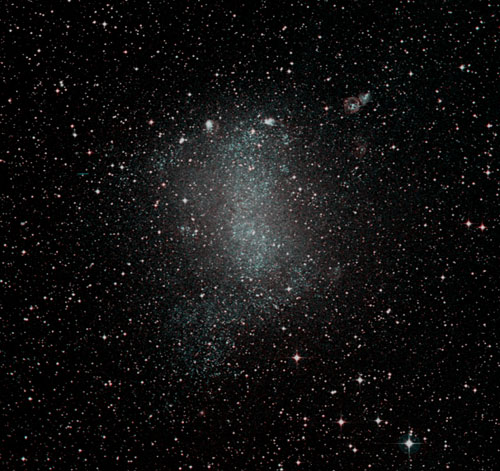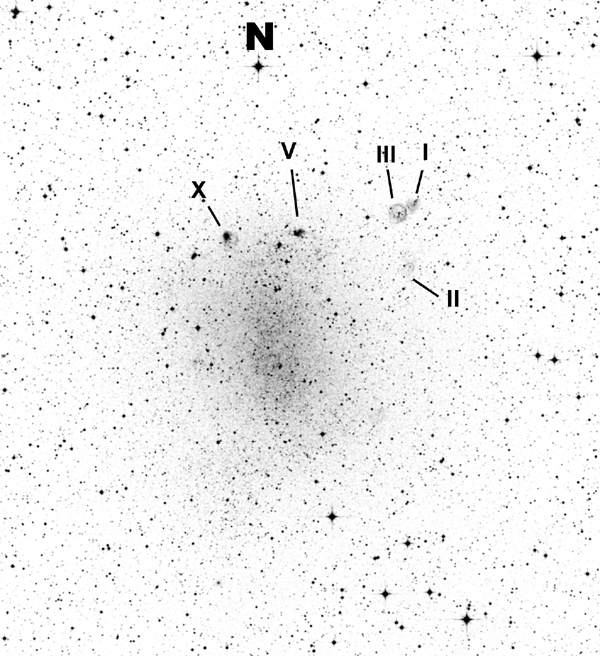 Barnard Galaxie
home
Barnard Galaxie
home
Barnard's Galaxy
NGC 6822 in
Sagittarius
April
2007
 NGC
6822 in the north-eastern corner of Sagittarius is an irregular dwarf galaxy of
our Local Group at approximately two thirds the distance to M31, the Andromeda
Galaxy. The dwarf galaxy does not display distinct structures as for instance
spiral arms. It resembles a bit the Magellanic Clouds, but is smaller and
appears in part due to its distance much dimmer.
NGC
6822 in the north-eastern corner of Sagittarius is an irregular dwarf galaxy of
our Local Group at approximately two thirds the distance to M31, the Andromeda
Galaxy. The dwarf galaxy does not display distinct structures as for instance
spiral arms. It resembles a bit the Magellanic Clouds, but is smaller and
appears in part due to its distance much dimmer.
NGC 6822
was discovered in 1884 by Barnard using a 5 inch refractor and was described as
an extremely dim nebula. 1925, Edwin Hubble examined the galaxy more in detail
and described several diffuse emission nebula, huge HII regions, within NGC
6822. Furthermore, he investigated several variable stars, Cepheids, by which he
was able to determine the distance of the galaxy.
From our northern latitude, a visual observation of Barnard's Galaxy is always
hampered by its low altitude in Sagittarius in the only short summer nights. The
low surface brightness of the galaxy and the star-rich environment at the edge
of the summer Milky Way further adds to its difficulty. Besides a dark sky, a
night with exceptional transparency down to the horizon are requirements for a
successful observation. Given that these conditions are met, the central part of
the galaxy can be glimpsed as a weak glow that is slightly elongated and that
extends over around 10 arc minutes. As Barnard discovered this galaxy with a 5
inch telescope, a large aperture telescope is not a strict requirement for a
successful observation. The sky conditions are much more important.
I had observed this galaxy during two nights
in June and July 2006 with very good transparency in the Black Forest nearby
Freiburg using my 22 inch Dob at 150x and 250x, corresponding to 3.7 and 2.2 mm
exit pupil. The galaxy appeared as a weak, but distinctly brighter patch that
was elongated in direction north-south. Orientation and size could be compared
with a DSS print of the galaxy. Using field sweeping made it easier to
distinguish the diffuse brightening of the galaxy. Interestingly, the glow of
the galaxy did not appear to be smooth, but slightly "noisy". The brightest
stars in NGC 6822 reach mag 15 to 16 and the grainy impression could be due to
the brightest start close to being resolved.
Even without nebula filter, several of the
bright HII regions in Barnard's Galaxy can be discerned, which are grouped in
the halo around the central bar of the galaxy. In particular at the northern
edge of the galaxy extending toward west is a group of HII regions, that can be
clearly identified using a narrow band filter. Several of these HII regions
appear more prominent than the galaxy itself, which lead historically to a
series of misunderstandings about the nature of NGC 6822. With some of the HII
regions, intrinsic detail can be seen at higher magnification. 10 putative HII
regions had bee catalogued by Hubble in his classical paper of 1925 and bear
Roman numerals, Hubble I to Hubble X.
Barnard's Galaxy is clearly an exceptional
galaxy and should be on any summer observing list. By the way, nearby is NGC
6818, a nice planetary with a bright disk.
 (click for larger image)
(click for larger image)
Images:
UK Schmidt Survey, Equatorial Red Plates (DSS
copyright). The Roman numerals indicate several of the HII regions
catalogued by Hubble.
Barnard's
Galaxy, NGC 6822, RA 19h 45, DEK -14°48'
Edwin
Hubble's original paper (Hubble E (1925) NGC 6822, a remote stellar system.
Astrophysical Journal 62:409)
Hodge 1977ApJS...33...69H
Hodge et al.
1988PASP..100..917H
A nice article about Barnard's Galaxy by Rich Jakiel is
here, together with more data to the HII regions
in NGC 6822
Another observing report by Peter Surma with more
background information is
here
Image by
Leonardo Orazi with further HII regions.

home
 NGC
6822 in the north-eastern corner of Sagittarius is an irregular dwarf galaxy of
our Local Group at approximately two thirds the distance to M31, the Andromeda
Galaxy. The dwarf galaxy does not display distinct structures as for instance
spiral arms. It resembles a bit the Magellanic Clouds, but is smaller and
appears in part due to its distance much dimmer.
NGC
6822 in the north-eastern corner of Sagittarius is an irregular dwarf galaxy of
our Local Group at approximately two thirds the distance to M31, the Andromeda
Galaxy. The dwarf galaxy does not display distinct structures as for instance
spiral arms. It resembles a bit the Magellanic Clouds, but is smaller and
appears in part due to its distance much dimmer.